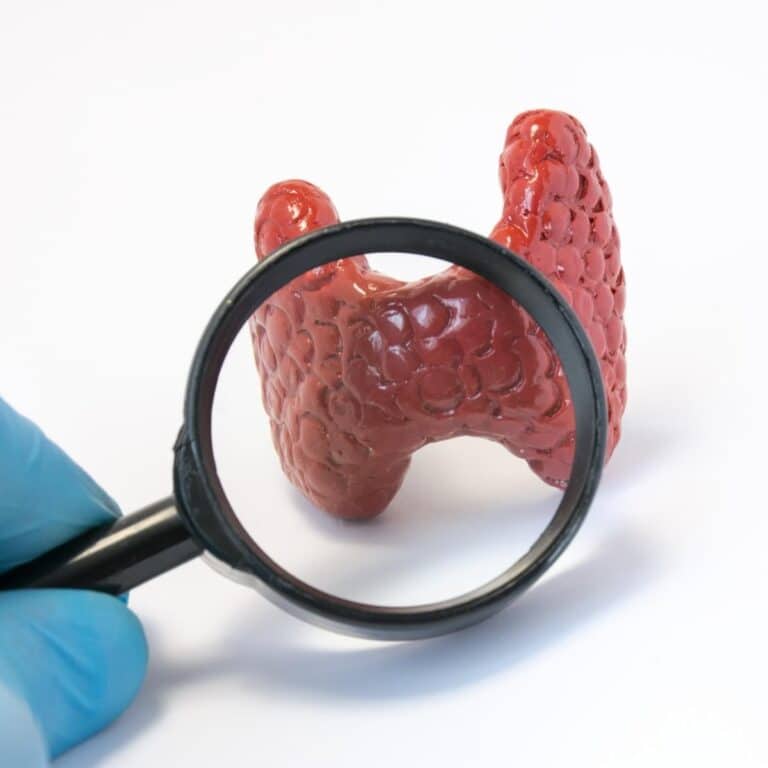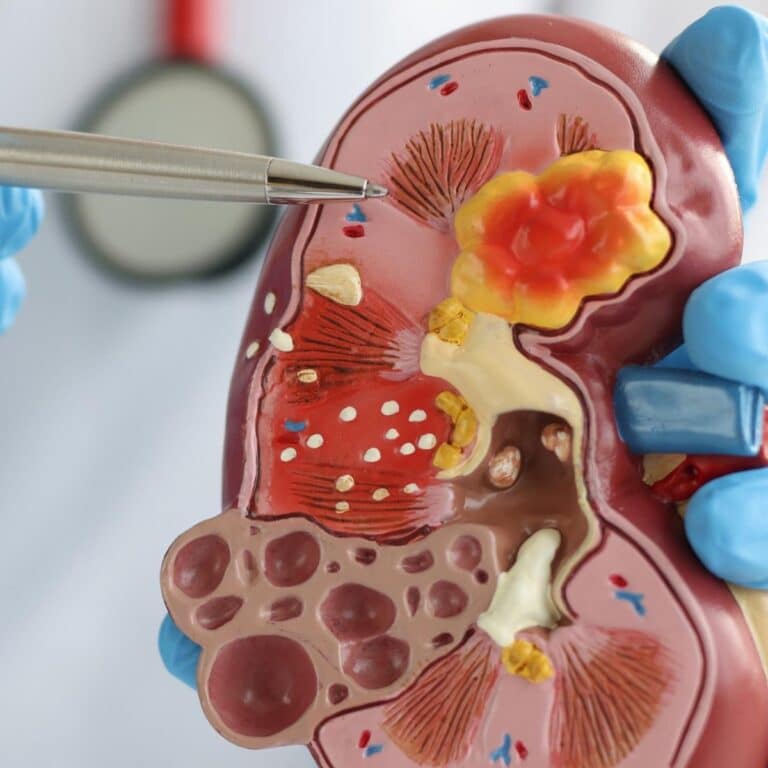Meal Planning for Families With CKD
At any stage of chronic kidney disease (CKD), meal planning is one of the most important factors to a healthy lifestyle. What you eat and drink has major implications to your health and comfort.
If you are cooking to feed a family and not just yourself, you want to be able to make kidney safe meals that your whole family can enjoy. After all, you do not want to have to cook separate meals for yourself and your family. Not only that, but it is always a good idea to start your family eating healthier, especially with a history of illness in the family.
In this article, we’ll talk about strategies on how to plan meals for the family when a member needs dietary modifications for a renal diet.
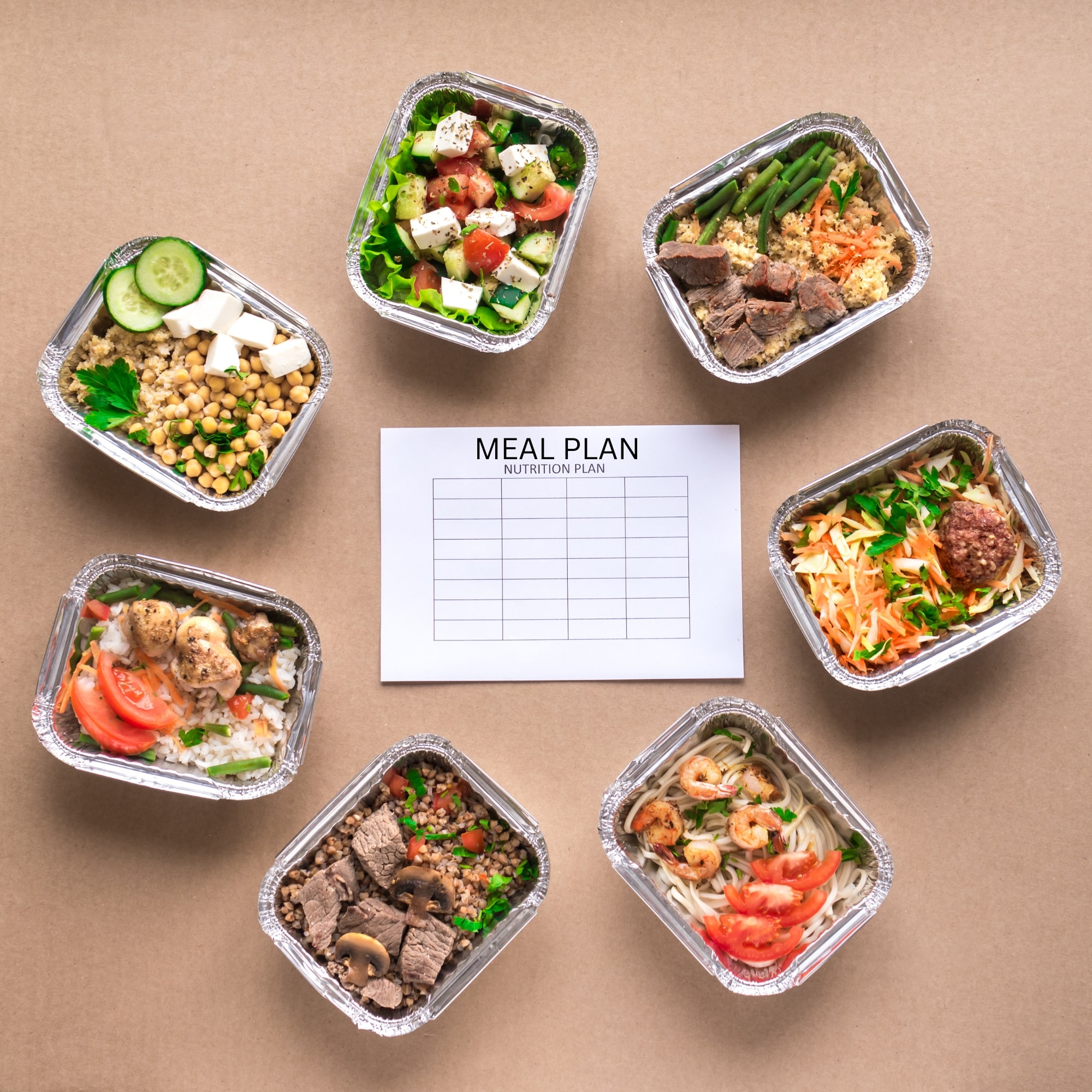
Jump to:
- Key Takeaways
- Understanding the Importance of a Kidney-Friendly Diet
- Implementing and Adapting Your Kidney-Friendly Eating Plan
- Important Factors in a Kidney-Friendly Diet
- The Significance of Meal Planning in Managing CKD
- Exploring Salt-free Seasoning Options for Tastier Meals
- The Benefits of Choosing Fresh Ingredients Over Canned Ones
- Discovering Delicious and Kidney-Safe Substitutes for Favorite Foods
- Creating and Enjoying Kidney-Safe Family Meals Together
- Frequently Asked Questions
- Your Kidney Friendly Diet Can Be Family Friendly, Too!
Key Takeaways
- A well-planned kidney-friendly diet is crucial for managing CKD in families.
- Choosing foods low in sodium, potassium, and phosphorus is important for maintaining kidney health.
- Consulting with a dietician and monitoring mineral intake, fluid levels, and potassium levels in the diet is essential for families with CKD.
For More Recipes and Ideas --->> Get Your Free Meals and Recipes That Are Perfect for Pre-Dialysis Diets, Pre-Dialysis with Diabetes, or Dialysis Diets.
Understanding the Importance of a Kidney-Friendly Diet
A kidney-friendly diet plays a pivotal role in managing Chronic Kidney Disease by mitigating the strain on these vital organs. Understanding the fundamentals of a renal diet is essential for people with kidney disease, as it involves specific restrictions to optimize kidney function and overall health. Here, we delve into the key principles and restrictions of a renal diet, shedding light on its profound impact on CKD management.
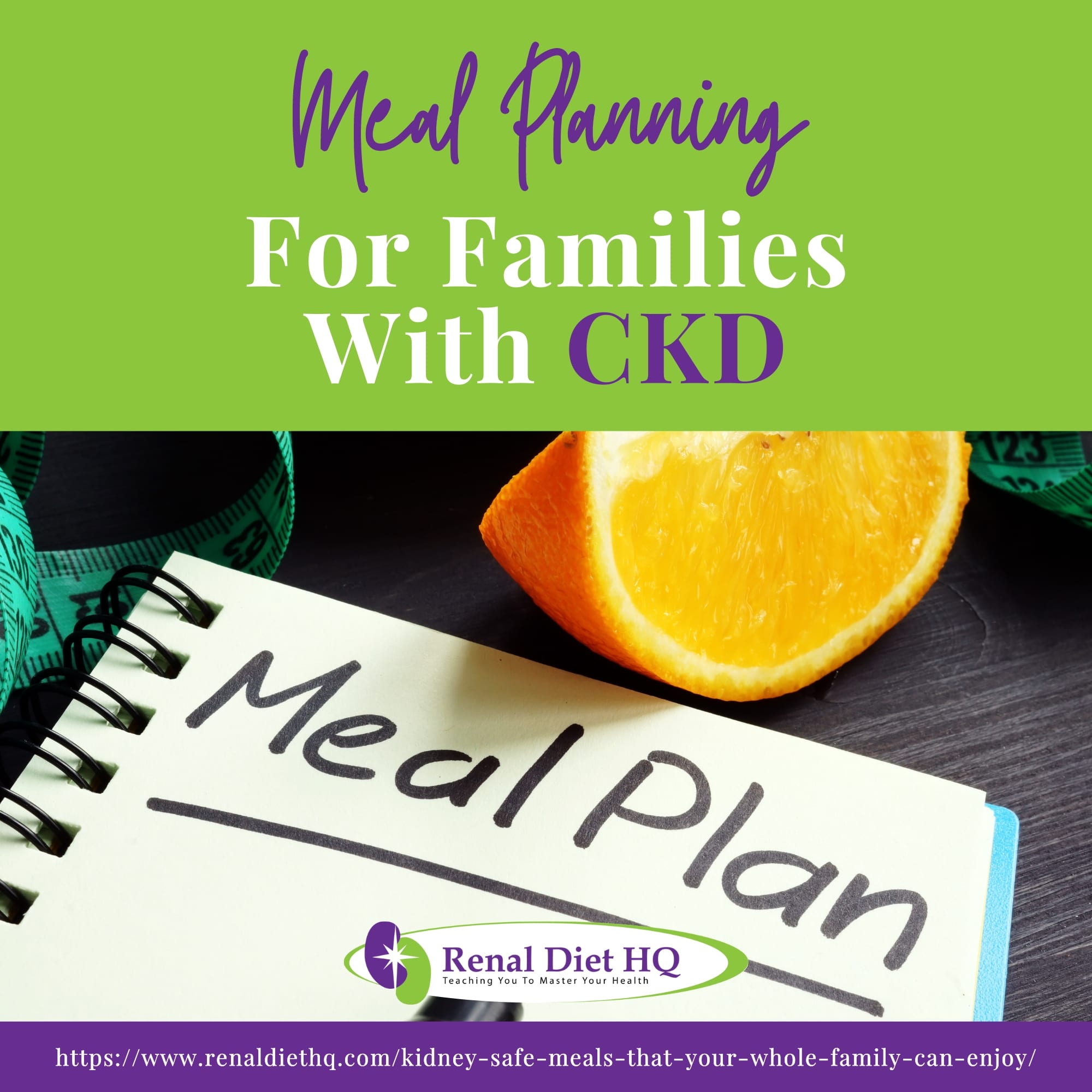
Kidney Diet's Role in CKD
The role of a renal diet in the management of Chronic Kidney Disease cannot be overstated. CKD is characterized by the gradual loss of kidney function, leading to a buildup of waste and excess fluids in the body. A well-designed renal diet is tailored to alleviate the strain on the kidneys, slow disease progression, and improve overall health.
First and foremost, a renal diet aims to regulate the daily intake of protein, phosphorus, potassium, and sodium. Protein restriction is essential to reduce the burden of waste products that the kidneys must filter, while controlling phosphorus and potassium helps maintain proper mineral balance in the blood. Sodium moderation aids in managing blood pressure, a crucial factor in CKD.
Moreover, adequate calorie intake is crucial to prevent malnutrition, a common concern in CKD patients. Hence, a balance must be struck intake of nutrients and calories. Hydration is also monitored, as excessive fluid intake can lead to edema and high blood pressure.
A renal diet plays a pivotal role in CKD management by alleviating the workload on the kidneys, preserving kidney function, and promoting overall well-being in individuals with this chronic condition. Consulting a registered kidney dietitian is essential to create a personalized renal diet plan tailored to an individual's specific needs and stage of CKD.
Dietary Restrictions in CKD
Meal planning for families dealing with Chronic Kidney Disease necessitates careful consideration of dietary restrictions to support the health of affected individuals. Key restrictions include:
- Protein Control: Reducing protein intake, particularly animal proteins, helps minimize the buildup of waste products in the blood. High-quality, lower-protein sources like fish, poultry, and plant-based options are preferred.
- Phosphorus Management: CKD often leads to elevated phosphorus levels in the blood, which can weaken bones. Limit phosphorus-rich foods like dairy, nuts, and processed foods with additives.
- Potassium Moderation: Elevated potassium levels can pose risks to heart health. High potassium foods, such as bananas, potatoes, and oranges, must be monitored and restricted.
- Sodium Restriction: Controlling sodium intake helps manage blood pressure and fluid retention. Processed foods, canned soups, and high-sodium condiments should be minimized.
- Fluid Monitoring: Fluid intake should be regulated to prevent fluid overload and edema. This includes accounting for liquid from foods like soups and fruits.
- Caloric Balance: Maintaining a healthy weight and preventing malnutrition is crucial. Calorie intake must be adequate while accounting for nutrient restrictions.
- Medication Interactions: Some foods can interact with medications, affecting their effectiveness. Knowledge of these interactions is vital.
Overall, meal planning for CKD involves balancing nutritional needs with these restrictions, promoting kidney health, and supporting the well-being of the entire family. Consultation with a registered dietitian is invaluable in creating customized meal plans that address individual needs and CKD stages.
Implementing and Adapting Your Kidney-Friendly Eating Plan
You've learned the importance of a kidney-friendly diet, but now it's time to put that knowledge into action. Adapting your eating habits for chronic kidney disease isn't as daunting as it may seem and we're here to guide you every step of the way.
Let's delve into how you can implement a kidney-friendly meal plan that not only benefits your health, but also suits your lifestyle and personal tastes.
Adapting Diet for CKD
Adapting typical family meals to a kidney-friendly diet for CKD patients involves making conscious and health-conscious choices. Start by reducing the protein content, especially animal-based sources, and focusing on lean cuts or plant-based sources of protein like tofu or black beans.
Be vigilant about phosphorus and potassium levels, opting for low potassium fruits and vegetables while limiting high-phosphorus foods like dairy products. Cutting back on salt and using herbs and spices for flavor can help control dietary intake of sodium.
Portion control is essential, particularly with high protein foods. Balancing meals with the guidance of a registered dietitian ensures that necessary nutrients are not compromised while adhering to dietary restrictions.
Involving the whole family in these changes can make mealtimes more inclusive, supportive, and healthy for everyone, aligning with the needs of CKD patients without sacrificing flavor or enjoyment.
Implementing Kidney-Friendly Plan
Adopting a kidney-friendly diet can make a big difference in your overall well being. This means understanding dietary restrictions, reading food labels carefully during grocery shopping, practicing portion control, and tracking intake of nutrients.
Here's a simple guide to help you:
| Dietary Restrictions | Grocery Shopping | Portion Control & Nutrient Tracking |
| Avoid high-sodium foods | Choose fresh low potassium fruits and vegetables | Use measuring cups or a digital scale |
| Limit protein intake | Buy lean meats | Keep daily logs of food consumption |
| Reduce phosphorus-rich foods | Choose low phosphorus vegetables | Monitor potassium, sodium, and protein levels |
Following this plan will not only support your kidneys but also promote healthier lifestyle choices. Remember to consult your healthcare provider before making any major dietary changes.
Important Factors in a Kidney-Friendly Diet
In the realm of kidney health, a well-structured renal diet is a cornerstone of management. In this section, we delve into the crucial factors that constitute a kidney-friendly diet. From the meticulous control of sodium intake to the delicate balance of protein, potassium, and phosphorus restrictions, understanding these elements is essential for individuals with kidney-related concerns.
Let's explore how each component plays a pivotal role in nurturing kidney health and overall well-being.
Managing Sodium Intake
Managing sodium intake in a family meal plan for a renal diet is of paramount importance in Chronic Kidney Disease management. Excess sodium can lead to elevated blood pressure and fluid retention, placing additional strain on the kidneys. To effectively control sodium:
- Read Labels: Scrutinize food labels for sodium content and choose low-sodium or salt-free products.
- Cook from Scratch: Preparing meals at home allows you to control sodium levels by using fresh ingredients and avoiding high-sodium additives.
- Limit Processed Foods: Minimize processed, canned, and fast foods, as they often contain hidden sodium.
- Use Herbs and Spices: Enhance flavor with herbs, spices, lemon juice, or vinegar instead of salt.
- Rinse Canned Goods: Rinse canned vegetables, beans, or other canned items to reduce sodium.
- Portion Control: Be mindful of portion sizes to avoid excessive sodium consumption.
By adhering to sodium restrictions in a renal diet, you help regulate blood pressure and fluid balance, which are critical for slowing the progression of CKD and maintaining overall health.
Choosing Healthy Proteins
Selecting healthy high quality proteins is a crucial aspect of meal planning for a family following a renal diet. In Chronic Kidney Disease, it's essential to balance protein intake to reduce the burden on the kidneys while still meeting nutritional needs.
Opt for lean high protein foods like skinless poultry, fish, and plant-based options such as tofu, legumes, and beans. Limit or avoid high-phosphorus protein sources like dairy and red meat, which can be detrimental to kidney health. Proper portion control is vital to ensure protein intake aligns with dietary recommendations.
Collaborating with a registered dietitian can help create balanced and delicious meals that cater to the entire family's protein requirements while supporting the dietary restrictions necessary for people with kidney disease.
Balancing Potassium in Diet
Restricting potassium in meal planning for families dealing with Chronic Kidney Disease is essential to manage potassium levels in the blood, which can otherwise become dangerously high. Here are some strategies:
- Choose Low-Potassium Foods: Focus on low potassium fruits and vegetables. Opt for apples, berries, green beans, and cauliflower over high-potassium options like bananas, oranges, and potatoes.
- Cooking Techniques: Certain cooking methods, like boiling, can leach potassium from foods. Rinse and boil vegetables before consumption to reduce their potassium content.
- Portion Control: Be mindful of portion sizes, as even low-potassium foods can contribute to high intake if consumed in large quantities.
- Limit High-Potassium Ingredients: Avoid or minimize high-potassium ingredients such as avocados, dried fruits, and tomatoes in recipes.
- Processed Foods: Reduce the consumption of processed foods, as they often contain added potassium-based additives.
- Consult a Dietitian: Work with a registered dietitian to create customized kidney disease meal plans that balance potassium restriction with essential nutrient needs for the entire family.
By implementing these measures, families can effectively manage potassium intake while still enjoying nutritious and satisfying meals that align with the dietary needs of CKD patients.
Managing Phosphorus
Managing phosphorus intake is crucial when meal planning for families dealing with Chronic Kidney Disease as high phosphorus levels can lead to complications such as bone and heart problems. Here's how to restrict phosphorus:
- Limit High-Phosphorus Foods: Reduce or eliminate foods rich in phosphorus like dairy products, nuts, seeds, and whole grains. Opt for lower-phosphorus alternatives.
- Watch for Additives: Be cautious of food additives like phosphates (often found in processed foods and sodas) that can significantly increase phosphorus intake.
- Choose Fresh Meats: Select fresh meats like chicken, turkey, and fish over processed or cured meats, which tend to have higher phosphorus levels.
- Dairy Alternatives: Substitute high-phosphorus dairy with non-dairy options like almond or rice milk, which are typically lower in phosphorus.
- Cooking Methods: Some cooking techniques like boiling can reduce phosphorus content. Pre-soak and rinse beans and grains before cooking to lower their phosphorus levels.
- Portion Control: Be mindful of portion sizes, as even lower-phosphorus foods can contribute to high intake if consumed excessively.
- Consult a Dietitian: Collaborate with a registered dietitian to create balanced kidney disease meal plans that meet the dietary restrictions of CKD while providing adequate nutrition for the entire family.
By incorporating these strategies into family meal planning, it's possible to effectively manage phosphorus intake and support the health of CKD patients.
Mindful Fluid Consumption
Managing fluid intake is critical when planning meals for families with members who have Chronic Kidney Disease to prevent fluid overload and maintain proper fluid balance. Here's how to effectively manage fluid intake:
- Know Individual Needs: Understand the specific fluid restriction guidelines for each family member with CKD. These recommendations are typically personalized based on the stage of CKD and individual health.
- Limit High-Fluid Foods: Be cautious with high-fluid foods like soups, broths, and foods with high water content like watermelon and cucumbers. Portion control is key.
- Monitor Beverage Choices: Encourage family members with CKD to choose beverages carefully. Limit sodium rich and high-potassium drinks like sports drinks, colas, and some fruit juices.
- Use Ice Chips: Offer ice chips or frozen fruit pieces as a way to provide a sense of hydration without excessive fluid intake.
- Limit Salt: Reducing sodium intake helps control thirst. Cook with less salt, and avoid high-sodium condiments and processed foods.
- Consult a Dietitian: Collaborate with a registered dietitian who can develop healthy eating plan and fluid restrictions tailored to the individual needs of family members with CKD.
Effectively managing fluid intake is essential in preventing complications like fluid retention and high blood pressure, promoting kidney health, and enhancing overall well-being for families dealing with CKD.
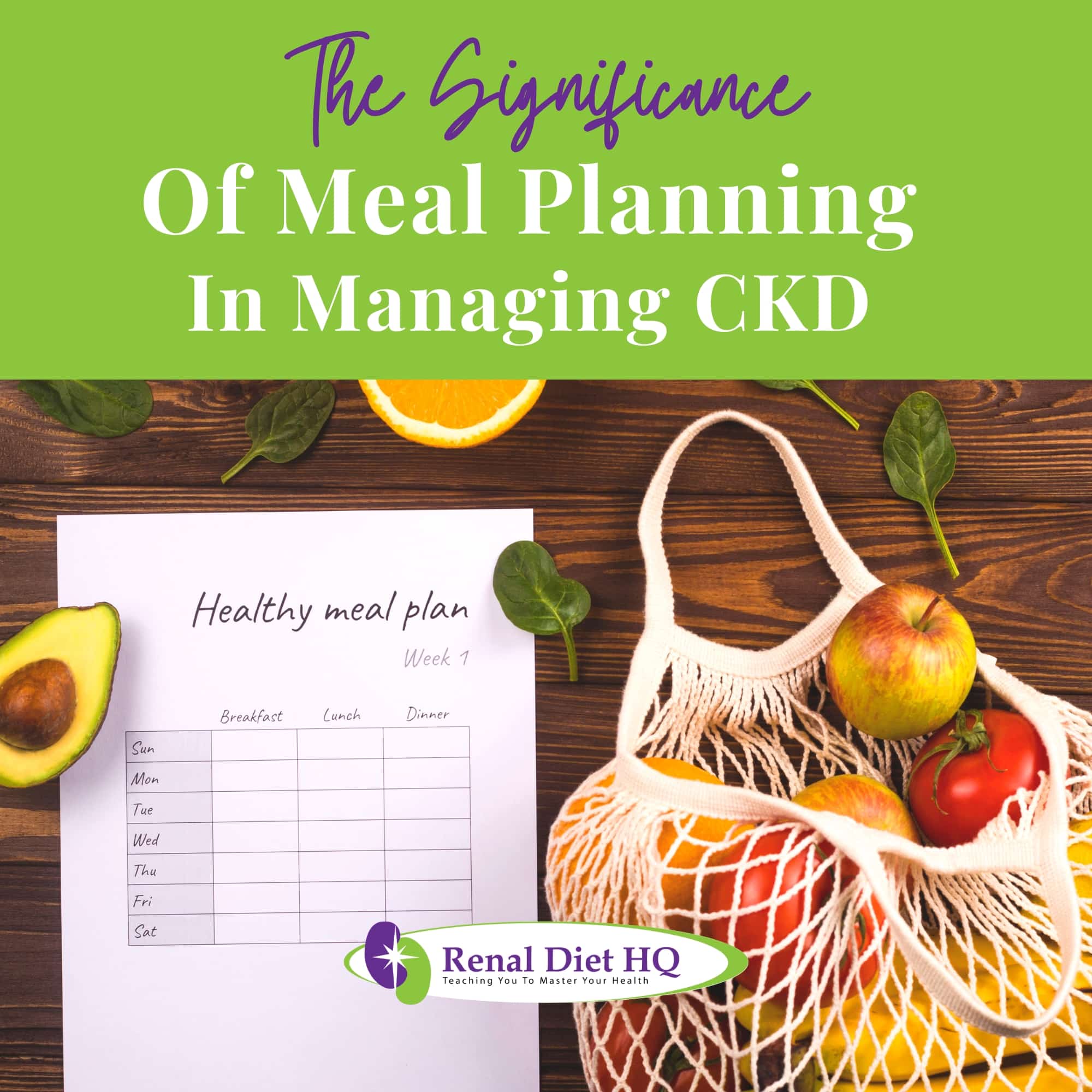
The Significance of Meal Planning in Managing CKD
Meal planning takes on heightened importance when a family member is diagnosed with Chronic Kidney Disease. Proper nutrition and dietary restrictions play vital roles in managing and minimizing progression of kidney disease. In this section, we delve into the significance of a healthy eating plan especially when a family member is dealing with a medical conditions especially a chronic illness.
From understanding dietary restrictions to optimizing nutrient intake, we explore how strategic meal planning can not only support the health of the CKD-afflicted family member but also foster an environment of wellness and unity within the family.
Benefits of Meal Planning
Meal planning for a family member on a renal diet due to Chronic Kidney Disease offers numerous benefits that extend beyond just managing the condition.
- Disease Management: A well-structured renal diet helps slow the progression of kidney disease, reduces complications like high blood pressure, and minimizes the strain on the kidneys, ultimately improving the patient's overall health.
- Nutritional Balance: Careful meal planning ensures that the patient receives essential nutrients while adhering to dietary restrictions. It prevents malnutrition and promotes better energy levels and overall well-being.
- Family Involvement: Inclusive meal planning encourages the whole family to adopt healthier eating habits. It fosters empathy, support, and unity among family members.
- Cost-Efficiency: Planning meals in advance reduces food waste and encourages cost-effective shopping, making it a budget-friendly approach.
- Stress Reduction: Knowing what to prepare in advance reduces mealtime stress and ensures that the patient consistently follows the prescribed diet.
- Improved Compliance: By accommodating the patient's dietary needs within family meals, adherence to the renal diet becomes easier and more sustainable.
Overall, meal planning for a family member with CKD not only contributes to their health but also creates a nurturing and supportive environment that benefits the entire family.
Meal Planning Challenges
Meal planning for families with a member requiring a renal diet due to Chronic Kidney Disease (CKD) can be challenging due to various dietary restrictions. Here are common challenges and possible solutions:
| Challenge | Solution |
| Limited Food Choices | Seek a registered dietitian's guidance to identify alternative ingredients and creative recipes within dietary constraints. |
| Balancing Nutrients | Collaborate with a dietitian to ensure meals meet nutritional needs while adhering to sodium, potassium, phosphorus, and protein limits. |
| Taste and Variety | Experiment with herbs, spices, and flavor-enhancing techniques to make renal-friendly meals more appetizing and diverse. |
| Family Preferences | Find compromise by modifying family-favorite recipes to meet renal diet requirements or identify shared dishes that align with restrictions. |
| Meal Planning Fatigue | Develop a weekly meal plan with rotating recipes to reduce monotony and streamline grocery shopping. |
| Budget Constraints | Plan budget-friendly meals by focusing on local, seasonal produce and affordable protein sources, and buying in bulk when possible. |
| Time Constraints | Utilize meal prep techniques like batch cooking to save time during the week, and involve family members in cooking to distribute the workload. |
These solutions can help families overcome challenges in meal planning for individuals with kidney conditions, making the process more manageable and supportive of the patient's dietary needs.
Exploring Salt-free Seasoning Options for Tastier Meals
As you navigate your journey with managing CKD, it's essential to explore the world of salt-free seasoning and healthier options for tastier meals.
Let's delve into how using herbs and spices can not only enhance the flavor of your dishes but also offer health benefits.
Alternative seasonings are more than just substitutes for salt—they're a key part of creating delicious, kidney-friendly meals.
Herbs and Spices Usage
Using herbs and spices to flavor meals is a smart and delicious strategy when preparing family meals for a member on a kidney diet due to Chronic Kidney Disease. It's especially important because reduced salt consumption is a key aspect of managing CKD.
Herbs like basil, oregano, thyme, and rosemary, along with spices such as cumin, paprika, and turmeric, add layers of flavor without the sodium overload of salt. Fresh herbs like cilantro, parsley, and chives provide a burst of freshness to dishes. Citrus zest and juice can also enhance taste.
By embracing these natural flavor enhancers, families can maintain the appeal of their favorite recipes while accommodating the dietary restrictions of the CKD patient. Moreover, it encourages healthier eating habits for the entire family, promoting a balanced and kidney-friendly diet.
Alternative Seasoning Benefits
Opting for seasonings, spices, and herbs over salt in a family-friendly renal diet plan offers a multitude of benefits. Firstly, it supports the management of Chronic Kidney Disease by reducing sodium intake, thus helping to control blood pressure and fluid retention, common issues in CKD.
Secondly, these natural flavor enhancers introduce diversity and depth of taste to meals, making them more enjoyable and appealing. This encourages family members to embrace a healthier, kidney-friendly eating pattern.
Additionally, using herbs and spices promotes creativity in the kitchen, allowing for culinary experimentation and the discovery of new, delicious recipes. By reducing reliance on salt and emphasizing these flavorful alternatives, families not only support the dietary needs of the CKD patient but also cultivate a broader appreciation for wholesome, nutritious, and satisfying meals that benefit everyone's health.
The Benefits of Choosing Fresh Ingredients Over Canned Ones
It should come as no surprise that fresh vegetables, beans, and more taste so much better than canned. Your whole family will notice the difference when the food on their plate is fresh and delicious, and your health will fare better for it too.
When you cannot find what you are looking for fresh, you can also turn to frozen as most of the vitamins and nutrients are preserved in freezing, and there are no extra preservatives like there are in canned. Whatever you can get that is the freshest, the better off you will all be.
Nutritional Value Differences
The nutritional value of fresh healthy foods far surpasses that of canned foods, making fresh ingredients the preferred choice for family-friendly and kidney-friendly meals.
Fresh foods are rich in essential vitamins, minerals, and antioxidants because they haven't undergone the high-heat canning process that can degrade these key nutrients. Fresh produce is also lower in sodium compared to canned counterparts, crucial for kidney health.
Moreover, fresh foods offer superior flavor and texture, making meals more appealing to both adults and children. This encourages the consumption of a wider variety of nutritious foods, which is essential in crafting well-rounded and kidney-friendly family meals.
While canned options may be more convenient, prioritizing fresh ingredients when meal planning ensures that the family receives the best possible nutritional support, especially when considering the dietary restrictions often associated with Chronic Kidney Disease.
Preservatives and Health Impacts
Preservatives in canned and processed foods can have significant health implications, particularly for individuals with Chronic Kidney Disease. Many processed foods are high in sodium-based preservatives like monosodium glutamate (MSG) or sodium benzoate, which can lead to elevated blood pressure and fluid retention, both detrimental to kidney disease patients.
Additionally, canned foods may contain phosphorus-based preservatives, further exacerbating the phosphorus imbalance common in CKD. Furthermore, certain preservatives can have adverse effects on overall health, potentially increasing the risk of other chronic conditions that often coexist with CKD, such as heart disease.
Therefore, for CKD patients, minimizing the consumption of processed and canned foods with high preservative content is crucial in managing the disease, preserving kidney function, and maintaining overall well-being. Opting for fresh, whole foods and cooking from scratch is the healthiest approach.
Discovering Delicious and Kidney-Safe Substitutes for Favorite Foods
You're probably wondering how to keep meals flavorful while also ensuring they're safe for your kidneys. In our next discussion, we'll delve into exploring kidney-safe substitutes for your favorite foods. We'll also cover how to enhance flavor naturally, giving you the ability to enjoy meals that are both delicious and beneficial for your health.
Exploring Kidney-Safe Substitutes
Kidney-safe substitutes for meal staples are essential for individuals with Chronic Kidney Disease who need to adhere to a renal diet. Here are some key substitutions:
- Protein: Replace high-phosphorus meats like beef and pork with lean cuts of chicken or turkey. For plant-based options, consider tofu or tempeh.
- Dairy: Swap dairy milk for lower-phosphorus alternatives like almond milk or rice milk. Use low-phosphorus cheeses or nutritional yeast sparingly.
- Grains: Choose white rice or pasta over whole grains like brown rice, wild rice, or whole wheat pasta, which contain higher phosphorus levels.
- Bread: Opt for white bread instead of whole grain or whole wheat bread, which have more phosphorus.
- Salt: Use herbs, spices, and low-sodium seasonings instead of salt for flavor enhancement.
- Potatoes: Substitute white potatoes for sweet potatoes or cauliflower, which are lower in potassium.
- Tomato Products: Replace tomato-based sauces and products with low-sodium or homemade alternatives.
These kidney-safe substitutes help individuals with CKD manage their dietary restrictions while still enjoying satisfying and flavorful meals. Consulting a registered kidney dietitian can provide personalized guidance on the best substitutions for specific dietary needs and CKD stages.
Enhancing Flavor Naturally
Incorporating herbs and spices into your dishes can naturally enhance their flavor without jeopardizing kidney health. Flavorful marinades, for instance, can be prepared using healthy condiments and homemade broths.
Don't shy away from using citrus - it's fantastic for livening up a dish. Roasting vegetables brings out their natural sweetness while also adding depth to your meals. Steamed vegetables with minimal seasoning is also a great option.
Here are some suggestions:
| Method | Ingredients | Benefits |
| Flavorful Marinades | Herbs, Spices, Citrus | Enhances Taste |
| Healthy Condiments | Turmeric, Garlic | Lowers Inflammation |
| Homemade Broths | Vegetables, Herbs | Packed with Nutrients |
| Using Citrus | Lemon, Lime | Adds Zest |
| Roasting Vegetables | Carrots, Potatoes | Caramelize Natural Sugars |
Remember to experiment with different combinations. It's about keeping meals tasty and kidney-friendly!
Creating and Enjoying Kidney-Safe Family Meals Together
Catering to the dietary needs of a member with Chronic Kidney Disease while ensuring kid-friendly healthy options can be a delicate balance. In this part, we explore the art of creating kidney-safe meal plans that not only support the health of CKD patients but also delight the taste buds of the little ones.
Discover how to strike the perfect harmony between nutritional requirements and family-friendly flavors, making mealtime a joyous and wholesome experience for everyone.
Kidney-Safe Meal Planning
Kidney-safe meal planning that accommodates the health needs and preferences of every family member is a delicate yet achievable balance. To create harmonious family meals:
- Consult a Dietitian: Seek guidance from a registered dietitian who specializes in renal nutrition. They can craft customized meal plans that meet the dietary restrictions of the CKD patient while ensuring balanced nutrition for all.
- Modify Family Favorites: Adapt beloved recipes to align with renal diet requirements. For instance, use lower-phosphorus dairy or reduce sodium content.
- Incorporate Variety: Introduce a wide range of kidney-safe ingredients to keep meals exciting. Experiment with herbs, spices, and flavorful low-sodium sauces.
- Family Involvement: Involve family members in meal preparation to foster a sense of participation and understanding of dietary restrictions.
- Delicious Options for Kids: Incorporate appealing, renal-friendly dishes that cater to the tastes of children. Consider dishes like grilled chicken skewers, vegetable stir-fries, or fruit salads.
By emphasizing communication, creativity, and collaboration, kidney-safe meal planning can nurture both the health and happiness of every family member, making mealtimes a source of unity and well-being.
Kid Friendly and Kidney Friendly Meals
Meal planning for kidney-friendly meals that cater to children in the family requires a careful and balanced approach. Begin by consulting with a registered dietitian who specializes in renal nutrition to create a foundation that meets the specific dietary restrictions of the CKD patient while ensuring kid-friendly options.
When selecting ingredients, prioritize fresh fruits, vegetables, lean proteins such as chicken or turkey, and whole grains. Limit foods high in phosphorus and potassium, which are often restricted in a renal diet.
To enhance flavor without relying on salt, use a variety of herbs, spices, and low-sodium seasonings. Gradually reduce salt in recipes to acclimate taste buds to lower sodium levels.
Adapt family-favorite recipes to align with renal diet restrictions. For instance, prepare a kidney-friendly pasta dish using ingredients suitable for both the patient and children.
Additionally, make meals visually appealing and colorful to pique the interest of children. Engage them in meal planning and preparation to foster a sense of involvement and curiosity about healthy eating.
For snacks, offer healthier options like sliced fruits, yogurt, crunchy vegetables, or low-sodium crackers that are suitable for both the CKD patient and the kids. By striking this balance, you can ensure that meals are both nutritious for kidney health and enjoyable for the entire family.
Frequently Asked Questions
For busy weekdays, quick and kidney-friendly recipes are essential. Try dishes like a simple grilled chicken breast with steamed broccoli and a side of quinoa. Another option is a stir-fry with lean protein (chicken, tofu) and a mix of low-potassium vegetables, served over brown rice.
You can also make a kidney-friendly pasta salad using whole wheat pasta, diced cucumbers, and cherry tomatoes with a lemon-herb vinaigrette. These recipes are easy to prepare, low in sodium, and can accommodate dietary restrictions for those with kidney concerns.
Maintaining a healthy diet while dining out or traveling requires careful planning. Before your trip, research restaurants that offer renal-friendly options, and check their menus online. When dining out, communicate your dietary restrictions to the server, and don't hesitate to request modifications to suit your needs.
Managing portion sizes is essential, so consider splitting meals or taking leftovers with you. Avoid high-risk foods like those high in sodium, potassium, or phosphorus. To stay prepared, carry kidney-friendly snacks for on-the-go.
Hydration is crucial, but be mindful of fluid intake within the recommended limits. Don't forget to pack your medications and adhere to prescribed doses while monitoring your potassium and phosphorus levels. These strategies will help you enjoy your outings or travels while maintaining your kidney-friendly diet.
Your Kidney Friendly Diet Can Be Family Friendly, Too!
Just because you are living with kidney disease or illness does not mean that you have to eat separately, or that you and your family cannot enjoy your meals together. There are plenty of kidney safe, family friendly meals that you can make. It all starts with a little planning.
Managing CKD in your family starts with a kidney-friendly diet. Monitor potassium, phosphorus, and fluid levels for optimal health. Explore salt-free seasonings and fresh ingredients to make delicious meals. Try kidney-safe substitutes for favorite foods and enjoy creating family meals together.
A well-planned meal is crucial in dealing with CKD effectively. Remember, you're not just eating right; you're enhancing the quality of life for your loved ones too!





